
As the 2013-14 school year ended, a ninth-grade biology assignment brought the debate of teaching creationism in public schools into the national limelight.
The assignment, which included a PowerPoint and accompanying guided notes packet, was intended to teach the standards of evolution and natural selection. The materials, however, included the definition of creationism and contained a controversial cartoon, which was originally published by Ken Ham, a creationism activist who debated Bill Nye last February on the subject on national television.
As originally reported by alumni Archie Kinnane ‘14 and Josh Weinstock ‘14 in the May 2014 issue of The Southerner, the PowerPoint was assigned to freshman biology students the week of April 14 by Grady teacher Anquinette Jones. The Southerner has since learned, however, that Jones was not the only Grady teacher to assign the materials. Biology teacher Shawna Brooks gave her students the assignment as well.
The teachers had obtained the lessons from an APS file sharing site, SharePoint, which were originally uploaded by APS project manager Mary E. King. After Grady administration received complaints from students and parents, both teachers took action to remove the cartoon from the materials assigned to students. Carrie MacBrien, Communications and Journalism academy leader, said a third biology teacher who had not taught the evolution unit decided not to present the PowerPoint content to students after originally planning to do so.
According to Linda Anderson, APS Assistant Superintendent for Teaching and Learning, the PowerPoint and all other resources referring to creationism were removed from SharePoint on April 21. She also said that there was no way to know how many APS biology teachers downloaded the PowerPoint presentation or used it in their classrooms.
The original news story about the “Evolution vs. Creationism” PowerPoint and cartoon was posted on The Southerner online edition on May 20. It attracted attention and news coverage from local and national media including United Press International, The Huffington Post, Christian News, The Atlanta Journal-Constitution and Georgia Voice. The increased attention has raised more questions about the PowerPoint and the pro-creationism cartoon that lies at the heart of the story.
GRADY AND APS ADDRESS THE ISSUE
As the new school year has set in, both Grady and APS have implemented measures to prevent similar problems in the future.
Principal Timothy Guiney, Grady’s principal as of July 1, has encouraged teachers to collaborate in lesson planning by creating “professional learning communities.” Teachers now meet once a week by content areas and grade level to plan curriculum and lessons as well as to evaluate student performance and make sure that all instructional activities conform to state-mandated curricular standards. He believes this collaboration will serve as a preventative measure to avoid issues with content in the future.
“There can be more sets of eyes on what it is we are about to present, as well as lesson plans being submitted each week to SharePoint,” Guiney said.
Guiney explained that if students report that inappropriate content has been presented, the administration will intervene and investigate.
“If an allegation comes in, an investigation takes place,” Guiney said. “Allegations are all different, because sometimes a student will allege something, and it will come out after an investigation that exactly what the student alleges is what occurred. Sometimes a student will allege something and an investigation occurs and we find out that’s not exactly how it happened. Sometimes an allegation will occur and we investigate and find out that it didn’t happen at all.”
Additionally, APS has made its process for reviewing SharePoint lessons more rigorous.
“The vetting process for teacher developed units and sample lessons has been revised so a more thorough review process is in place prior to information being posted to the district SharePoint site for teacher use,” Anderson said. “All lessons that are uploaded must now be accompanied by a completed APS ‘Unit Plan Completion Feedback Form.’ The submitted information is reviewed prior to being uploaded.”

Anderson said teacher curriculum will also be more closely monitored this year.
“Teachers will be reminded of the need to teach only to the standards as they prepare to teach the course in Spring 2015,” Anderson said. “Information will be shared with instructional coaches and department chairs across the district this fall and spring. This information will also be shared with associate superintendents and principals. A new unit plan [for evolution and natural selection] is being developed and will be fully uploaded with professional development provided to instructional coaches to redeliver to teachers before the unit is taught in the spring.”
Matt Cardoza, Georgia Department of Education Director of Communications, confirmed that evolution is part of the Georgia Performance Standards for biology and that creationism is not. Cardoza said creationism may be referenced in class but it may not be taught as a standard. The standards require that instructors teach biology students the theory of evolution and natural selection.
According to Cardoza, Georgia’s Performance Standards in science are important for educating Georgia students for both state and national education standards. The standards are covered in the high school graduation test, as well as on college entrance exams such as the ACT.
“[The Georgia Performance Standards are] what you want a kid to know about all the particular subject areas,” Cardoza said. “It’s what the students are going to be tested on, not just here in Georgia, but also when trying to get into college. [Evolution] is important because of the standards. If a teacher doesn’t teach a particular standard then that means that a student’s not learning that particular material and what is ultimately going to be tested. That student is not likely to do very well on that portion of the test.”
IN THE CLASSROOM
On April 15, Jones assigned her biology classes the PowerPoint to read to cover the unit on evolution and natural selection. The students had access to the assignment on Blackboard, an online teaching tool which allows teachers to share assignments and learning resources with students.
The assignment elicited student and parent protest, which led to the news coverage that was published in The Southerner in May. Maureen Downey discussed the incident in her Get Schooled education blog on the AJC website on July 3, which led state and national outlets to report the story.
In the aftermath of this coverage, on July 10, Jones wrote a email to APS officials defending her decision to assign the PowerPoint and asserting that the Southerner story falsely accused her of teaching creationism. The Southerner obtained a copy of the email through an open records request. In the months since the controversy of the PowerPoint first became known, Jones has steadfastly denied that she taught creationism.
In order to uncover a fuller picture of these events, The Southerner conducted more interviews of students who were in the class. Jones declined to be interviewed saying she did not trust The Southerner to cover the subject fairly.
Student accounts of Jones’s teaching last April reveal she did not lecture to her students about creationism or evolution but rather had them read the assigned PowerPoint document and take notes.
“She never straight up said, ‘This is creationism,’ but she never straight up said, ‘This is evolution,’” said Jamie Panarites, a sophomore who was in Jones’ class as a freshman. “She didn’t really teach either one. She just gave us a PowerPoint and was like, ‘Here, take notes on this,’ and then the PowerPoint had those slides on it.”
Grace Madlem and Tyler Randall, other former students in Jones’ biology class, remember receiving printed packets with the same materials that were on the PowerPoint.
“It was a packet of fill-out work about evolution,” Madlem said. “And then one of the pages just talked about creationism versus evolution and then the different sides. I didn’t read it that thoroughly, I just looked straight at the cartoon.”
After the PowerPoint was assigned, the administration received complaints from students’ parents. In four separate emails obtained by The Southerner through open record requests, Grady parents expressed concern about the assignment of the creationism cartoon.
The following class day, according to Madlem, Jones distributed a new packet omitting the page with the cartoon. The PowerPoint was also removed from Blackboard.
Jared Steckl, who also had Jones in the 2013-2014 school year, believes Jones was not trying to teach creationism when she assigned the PowerPoint or trying to push her personal beliefs and opinions on the subject.
“She doesn’t go up and start preaching to the class or praying,” Steckl said. “But she has a Bible on her desk. She doesn’t use it in front of us, but she has it right there.”
Grady alums Tia Borrego and Olivia Volkert who took Jones’ AP Biology class last year, claimed they were never taught evolution, nor did they receive the PowerPoint or packet.
Principal Guiney said that standardized test data suggests that Jones taught evolution to her freshmen biology students.
“Ms. Jones had an 87 percent pass rate on the End of Course Test last year in biology,” Guiney said. “The state’s pass rate was 75 percent. The kids scored an average of 86 percent who had her class. In the evolution domain, her students got 76 percent of the of the EOCT questions right; it’s her second highest domain. So what it seems to indicate when we look at this being her second highest, the data, and again I was not in the classroom, but the data would indicate that she taught this.”
Guiney added, however, that creationism and religion are not appropriate subjects for a biology class.

“I still say that every teacher has to look at what is on a SharePoint portal and determine the appropriateness,” Guiney said. “But unfortunately there is probably an implicit expectation that if it’s on the school district portal, it’s good, it’s good to go, I can download it and start teaching because I assume, but you know the teacher does have a responsibility.”
Guiney speculates that there were many teachers throughout the system who used the PowerPoint without incident. Anderson said the district has no way of knowing how many teachers downloaded the PowerPoint or taught using it. According to Anderson, teachers typically work on lesson plans during the summer and then upload them to SharePoint during a pre-planning period before the start of school.
“Last year, teachers received links to the unit plans and how to use them at content specific professional learning opportunities,” Anderson said. “Instructional coaches from schools received professional learning on how to support teachers with the implementation of the units.”
Brooks also assigned the packet to her students; however, the day it was assigned to her A-day students, Communications and Journalism Academy Leader Carrie MacBrien asked for it to be removed from course materials after she received calls and emails from parents. MacBrien called the students in one class to her office where Brooks collected the packet. Brooks later distributed the packet omitting the cartoon to her students.
“She [MacBrien] kind of just made a general announcement for everyone [in my honors biology class] to come to her office, and she just kind of took it up,” Brooks said. “So when she did that it was kind of already out to my B-day students. But, I didn’t receive any comments so I was like, I’m not going to mention it so that they make a hooplah about it, because no one mentioned it.”
Brooks believes the materials served to illustrate the controversy between creationism and evolution, not to teach creationism.
“You need to know the difference,” Brooks said. “It’s just to say hey, this is why there is so much controversy. This is why we had all these laws in place because we want to be very clear cut about what we think and what we are teaching. And I think more importantly, that is the reason why it was even mentioned in my opinion. I don’t think there is a place for any personal beliefs in a science classroom.”
THE POWERPOINT
Since the story went viral, many questions have been raised on the merit and content of the PowerPoint. Andrew Petto, a senior lecturer of science and evolution education at the University of Wisconsin–Milwaukee who has published work on the subject, wrote a critique of the PowerPoint after Downey asked for a reader with experience in science education to critique it. In his critique, Petto concludes not only that the PowerPoint is inappropriate but also factually incorrect.
“What I found there is that the material in that PowerPoint showed a really powerful misunderstanding of the body of science,” Petto said. “If the materials the teachers use has a significant misunderstanding of the [biology standards] to be conveyed to the students, we can hardly expect for the students to get a very good education about those particular items.”
[slideshow_deploy id=’57186′]
The PowerPoint is more than 50 slides largely consisting of material about evolution. One slide, and a page in the packet of notes, defines both evolution and creationism. Under the definitions is the cartoon, which depicts evolution and creation as two dueling castles: one labeled “Creation (Christ)” and the other labeled “Evolution (Satan).” Balloons attached to the evolution castle were labeled euthanasia, homosexuality, pornography, divorce, racism and abortion.
Ham originally published the cartoon in his 1987 book titled, The Lie: Evolution. It was illustrated by Steve Cardno, the current art director for Creation magazine. In his book, Ham portrayed the cartoon as an example of the mistakes Christians make in the “war” against humanism. According to Ham, the cannons depicted in the cartoon ought to be aimed at the evolution base instead of the issues highlighted in the balloons.
“Christians are fighting a war,” Ham wrote. “But they don’t know where to fight it or how to aim their guns. This is the real problem. … If the Church wants to be successful in changing society’s attitudes toward abortion, pornography, and homosexuality, it is going to have to fight the issue at a foundational level. The foundational basis of evolution needs to be destroyed and the foundational basis of creation restored to its rightful place of importance.”

The next slide after the cartoon states that evolution is part of the curriculum and tells students, “you are entitled to challenge everything and encouraged to believe whatever you would like.”
According to Petto, the PowerPoint casts doubt upon evolution and portrays it in a negative light.
“The PowerPoint is basically a ‘wink-wink, nod-nod,’” Petto said. “You know, those kinds of things where it says, ‘I’m teaching this because I have to.’ It undermines the way that scientists understand evolution and why it is so widely accepted by scientists. It makes it seem as though it’s all just a matter of opinion and any high school student who has a different opinion is just entitled to it.”
A FINE, LEGAL LINE
The role of religion in public education has been a debate since the drafting of the U.S. Constitution. In the past, numerous cases have gone to the Supreme Court questioning the constitutionality of teaching creationism in public schools. The court has ruled in each that creationism is not a subject for the classroom.
The Establishment Clause to the First Amendment of the U.S. Constitution creates a separation between the church and state. This clause not only forbids the state from establishing a national religion but also prohibits the promotion of religion in government-run institutions, including public schools.
“The First Amendment basically places the state in a situation of neutrality,” said Lynn Hogue, a law professor at Georgia State University. “It doesn’t take sides in religious controversies, and it stays out of the religion business altogether. The reason we don’t allow public endorsement of religion is because of its controversial, dangerous nature, and we don’t allow the state to coerce people about belief.”
In order to determine whether the Establishment Clause is violated, the Supreme Court created the Lemon Test, named for the 1971 Supreme Court case Lemon v. Kurtzman. The test is three-pronged and outlines the qualifications a governmental action must meet in order to be allowable in a public school. The court has upheld in multiple cases that schools cannot include creationism as part of the science curriculum or force teachers to teach creationism.
One example, is the 1987 Supreme Court case Edwards v. Aguillard. In the case, the court ruled that Louisiana’s “Creationism Act,” which prohibited the teaching of evolution in public schools unless it was accompanied by creationism, was unconstitutional because the act “endorses religion in violation of the First Amendment.”
“That decision makes it crystal clear that creationism cannot be taught in public schools,” said Alex Luchenitser, the associate legal director of Americans United for Separation of Church and State. “Regardless of whether evolution is taught or not.”
On April 16, the day after she assigned the PowerPoint to her students, Jones wrote an email defending the assignment to Tommy Molden, APS science coordinator.
In the email, obtained by The Southerner through an APS open records request, Jones included several sentences that centered on the Edwards v. Aguillard case.
The message quotes this passage from the court’s decision: “Teaching a variety of scientific theories about the origins of humankind to school children might be validly done with the clear secular intent of enhancing the effectiveness of science instruction.”
Jones’s email also includes the following unattributed analysis of the court case: “The Supreme Court noted that teachers ‘already possess’ the flexibility to supplement the present science curriculum with the presentation of theories, besides evolution, about the origin of life, and are ‘free to teach any and all facets of this subject’ of all scientific theories about the origins of humankind. This is clearly a ‘green light’ for scientific creationism to be taught, even though its teaching cannot be mandated, and even though it prohibits the teaching of Biblical Creationism.” The sentences are a verbatim passage from the “guidelines for teachers” section of Robert L. Simond’s 1989 article, “Teachers Can Teach Creation Science in the Classroom,” which appeared in Acts & Facts, the monthly news magazine of the Institution for Creation Research. The article is also posted on the organization’s website.
According to the website, the organization’s purpose is to “equip believers with evidence of the Bible’s accuracy and authority through scientific research, educational programs, and media presentations, all conducted within a thoroughly biblical framework.”
Jones’s email to Molden concludes with the sentence: “I felt well within my right to present to my students a balance approach to evolution as identified on the district website [SharePoint].” Luchenitser disagrees with the conclusion that the Edwards decision permits teaching creationism in the context of teaching evolution. Instead, he argues, the case establishes exactly the opposite, that creationism cannot be taught as an alternate theory alongside evolution.
“There is a quote in the case that said various scientific theories of the origins of life could be taught,” Luchenitser said. “But creationism is not a scientific theory. Creationism is religion.”
In a 1982 Supreme Court case, McLean v. Arkansas Board of Education, the court also ruled that an Arkansas statute that required public schools to give balanced treatment to “creation-science” and “evolution-science” was unconstitutional. The judge’s logic: “since creation science is not science, the conclusion is inescapable that the only real effect of Act 590 [the Arkansas statute] is the advancement of religion.”
 Ashley Berner, a professor at Emory University and Deputy Director of the City University of New York Institute for Education Policy at Roosevelt House, an organization dedicated to improving education in the United States, agrees that creationism is religious doctrine not scientific theory.
Ashley Berner, a professor at Emory University and Deputy Director of the City University of New York Institute for Education Policy at Roosevelt House, an organization dedicated to improving education in the United States, agrees that creationism is religious doctrine not scientific theory.
“Creationism has its basis in a literal reading of Genesis and as such, is inextricable from religious belief,” Berner said. “K-12 schools are forbidden to teach about creationism as if it were anything other than a religious belief, and teaching about it as a religious belief it has to be done in a context in which the teacher and the school are not endorsing it as truth or encouraging people to believe it.”
Hogue agrees.
“[Creationism] has no place in a science classroom,” Hogue said. “You could acknowledge that this information is out there, but it has nothing to do with science. The problem is if you take the cartoon as truth, in other words as effectively setting off creationism against evolutionary theory, you cross a line where you endorse creationism as true and that’s the thing you can’t do. You can’t say creationism is true.”
According to Petto, this is exactly what the PowerPoint did.
“It clearly informed students that creationism was an alternative model that is equivalent to evolution as a scientific explanation,” Petto said. “Even if that information was only contained in a few places out of the 50 plus slides; the message is pretty clear that the students can ‘believe in’ creationism as an equivalent scientific explanation of the history and diversity of life on earth.”
SCIENCE ILLITERACY FUELS RELIGION V SCIENCE
Although evolution is widely accepted as fact in the scientific community, the American public is much less convinced. According to a 2014 poll conducted by Gallup, 42 percent of American adults hold creationist views of the origin of man; when asked to select the statement that best described their opinion, 42 percent chose the statement that “God created humans in present form.” Only 31 percent chose the statement that “Humans evolved, with God guiding,” and an even smaller percentage–19 percent–held that “Humans evolved, but God had no part in process.” These percentages have hardly shifted since 1982.
According to Hogue, this debate takes place in the classroom more than scientists would like to believe.
“The less that the teacher knows about the subject that they teach, the more likely they are to be vulnerable to community and religious pressures,” Hogue said. “The more you get out in a rural community or a community that is dominated by conservative religious groups the more they’re going to be pressured to equate creationism with biological science, but it’s not science, its just religion.”
Barbara Forrest, a member on the National Center for Science Education’s Board of Directors, said it is a widespread problem across the United States.
“[The NCSE] get calls all the time from people who need help defending the teaching of science in their schools,” Forrest said. “We keep data on where these calls come from. There are only about six states in the country where there have not been any problems with evolution; otherwise, the problems have sort of spread across the country, but they tend to cluster more in the South and the Midwest.”
Some Southern states, in violation of past Supreme Court rulings, have allowed creationism to be presented in the classroom as an alternative to evolution. In 2008, Louisiana passed the Louisiana Science Education Act, which permits public school teachers to use supplemental textbooks and materials to “help students understand, analyze, critique and review scientific theories.” The act specifically cites evolution, global warming and human cloning as examples of those scientific theories. Tennessee’s 2012 state law similarly allows public school teachers to teach “scientific strengths and scientific weaknesses” of theories in science that can “cause controversy.” This law also cited evolution, global warming and cloning.
 “Louisiana and Tennessee passed laws that were attempting to give teachers more leeway in terms of how we teach science,” Luchenitser said. “It’s another way to try to sneak creationism into the classroom. … Teachers who are actually teaching creationism based on those laws are violating the Constitution. Laws can not supersede the Constitution.”
“Louisiana and Tennessee passed laws that were attempting to give teachers more leeway in terms of how we teach science,” Luchenitser said. “It’s another way to try to sneak creationism into the classroom. … Teachers who are actually teaching creationism based on those laws are violating the Constitution. Laws can not supersede the Constitution.”
In order for these laws to be declared unconstitutional they must first make their way to court. Although there have been attempts by local politicians to repeal the two state statutes, none have been successful.
According to an article published by Slate magazine on Jan. 26, 2014, Georgia is one of 10 states using taxpayer dollars to fund scholarship programs or vouchers to private schools where creationism is taught. At least 34 schools such as these exist in Georgia. Another two states teach creationism in charter schools.
Sarah Pallas, a professor of neuroscience and biology at Georgia State University, has worked to promote science education in Georgia through an organization called Georgia Citizens for Integrity in Science Education. Pallas says failing to distinguish between faith and science harms society in two significant ways.
 “First is the extremely high level of scientific illiteracy in this country in general and in the South in particular,” Pallas said. “[This is] caused in part by inadequate or ineffective school funding and insufficient STEM [science, technology, engineering and math] teacher training. Without an interested, well-trained teacher, and without a well-equipped science lab, learning science is quite a challenge. Second, and possibly a large contributor to the first, is the infection of education policy by politics and religion. Some politicians and religious leaders think they have something to gain by pitting science and religion against each other, and telling regular folks that they have to choose between the two.”
“First is the extremely high level of scientific illiteracy in this country in general and in the South in particular,” Pallas said. “[This is] caused in part by inadequate or ineffective school funding and insufficient STEM [science, technology, engineering and math] teacher training. Without an interested, well-trained teacher, and without a well-equipped science lab, learning science is quite a challenge. Second, and possibly a large contributor to the first, is the infection of education policy by politics and religion. Some politicians and religious leaders think they have something to gain by pitting science and religion against each other, and telling regular folks that they have to choose between the two.”
Hot button issues in politics today such as climate change, stem-cell research and required vaccinations all relate back to science. According to a 2009 study conducted by the Pew Research Center, 84 percent of scientists believe that human activity has caused global warming while only 49 percent of the public hold the same view. There is also a stark partisan divide over the role of humans in global warming. Sixty-four percent of Democrats believe global warming is due to human activity while only 30 percent of Republicans do.
Similarly, those who attend church once a week or more are far more likely than the total public to oppose embryonic stem-cell research. Just over half church attendees oppose stem-cell research, while 35 percent of the general public opposes it.
Pallas says that science does not attack religion and should not be seen as an obstacle to faith.
“Science and religion address different spheres of human existence,” Pallas said. “Science has no comment on the supernatural and deals only with the natural world. Most scientists in this country would consider themselves religious, and most mainstream religions have specifically stated that modern science, including evolution, poses no threat to their faith.”
The interplay between faith and science can directly affect what happens in the science classroom, and sometimes, Petto says, that influence has a political taint. He says the role of politics in science education skews the knowledge of students across the country.
“What we have is a huge inconsistency from one school district to another, from one state to another, and really from one classroom to another in terms of the way that the science is presented in these classrooms,” Petto said. “And I think that is part of the problem.”
Grady biology teacher Nikolai Curtis contributes the large disbelief of evolution to a misunderstanding of the theory.
“When we talk about evolution, the biggest problem [is that] people automatically assume that it’s the idea that we came
from primates,” Curtis said. “What evolution discusses, is that we share a common ancestor with primates, but it never says that we came from them. For some reason, people feel less important or less human if they have to try to accept that fact. Because of that, we have to look past the personal connection and realize that it doesn’t make us less human to look at science and say, ‘Wow, this is great and this affects me and this is where I may have come from.’”
According to Petto, students are not able to understand biology without first learning evolution
“It really ends up giving you a very inefficient view of biology where there isn’t any regularity connecting things and that’swhat you lose,” Petto said. “It’s like trying to teach chemistry without teaching about atoms and electrons. We want students to understand science. We want students to understand why scientists think that creationism is not science.”.
As scientific and technological advances take place, Petto laments, society has yet to catch up.
“We’ve got this wonderful progress in science,” Petto said. “These tremendously productive theories that are very satisfying, that are a very powerful context and very useful and somehow half of the people in the United State of America don’t accept one of the most important ones. So what are we doing wrong?”

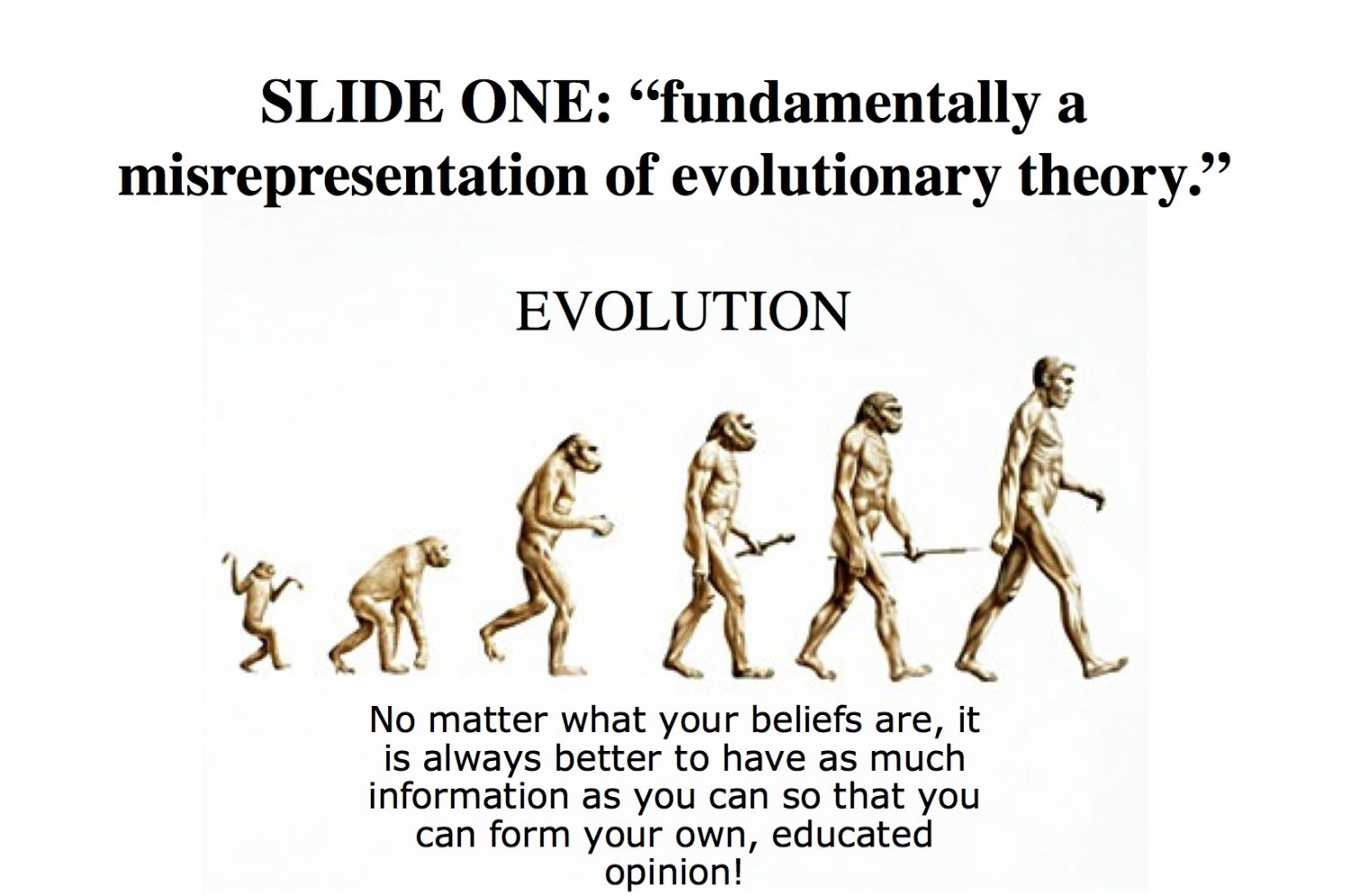

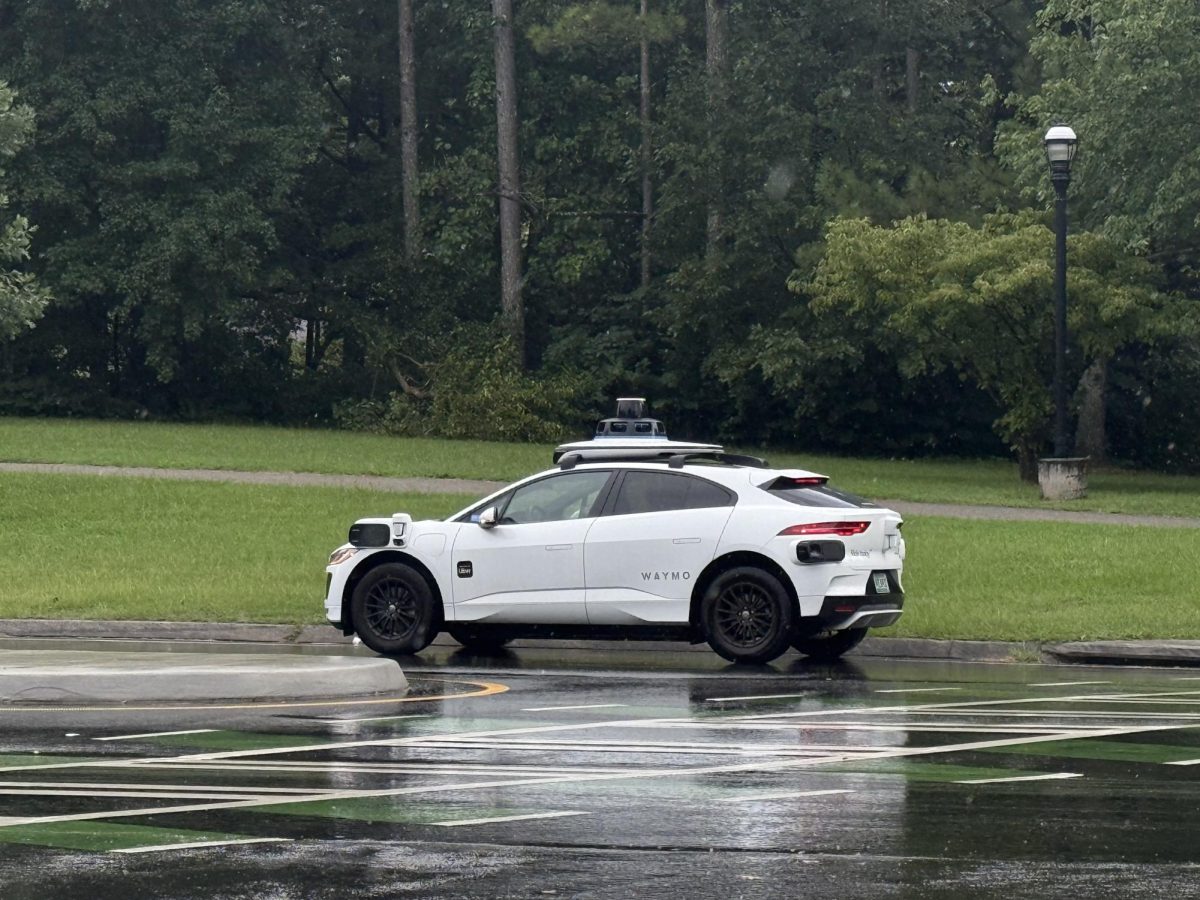
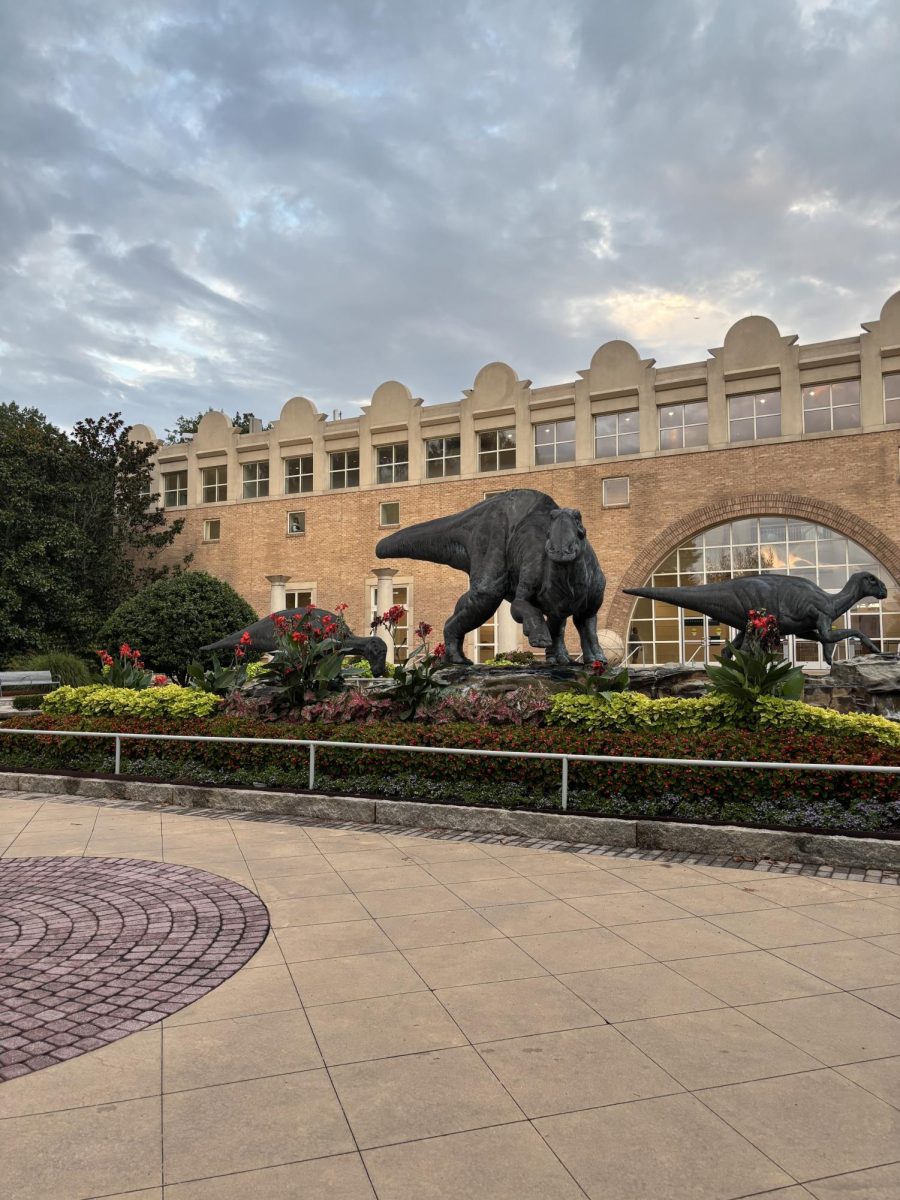




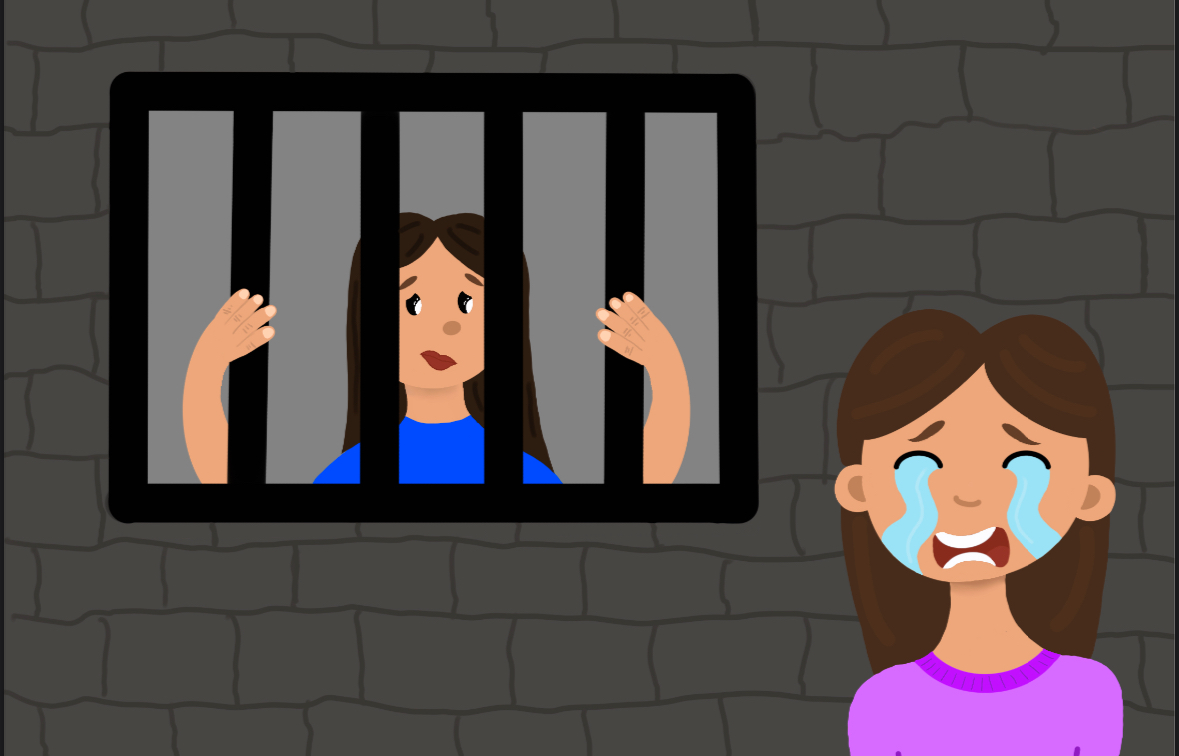


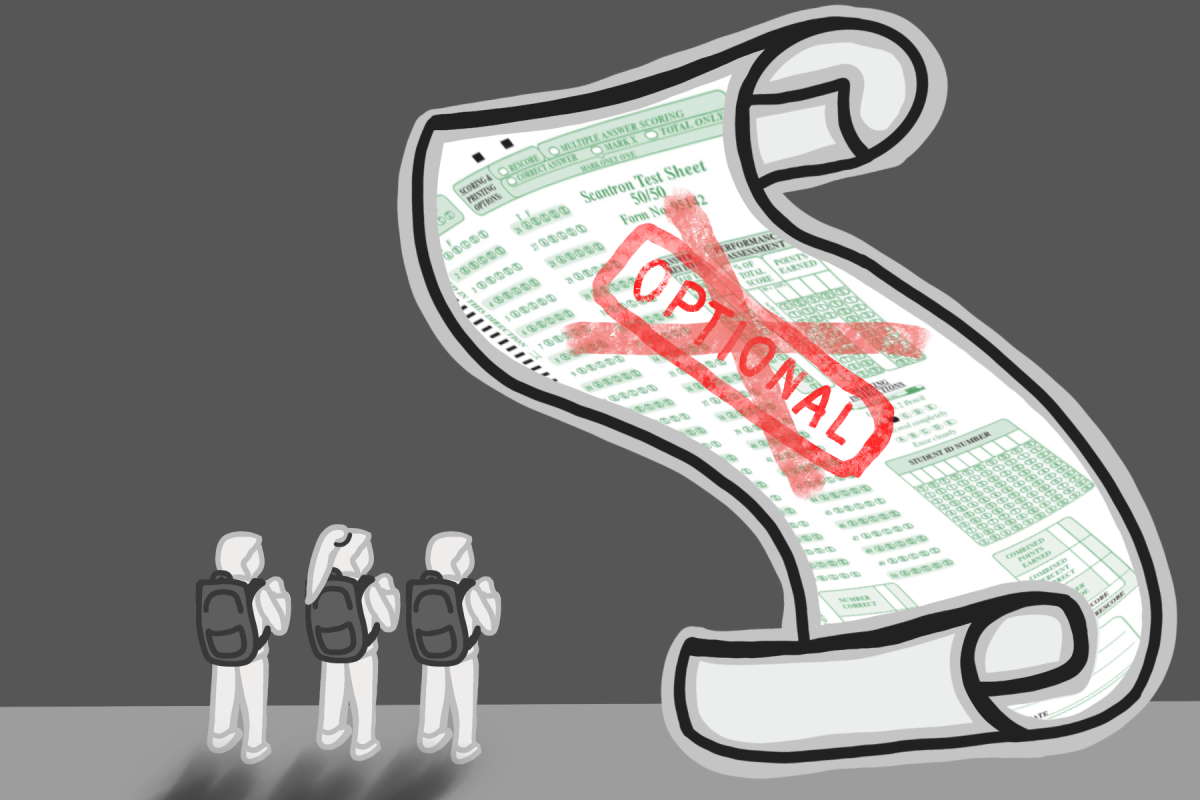


robert • Oct 2, 2014 at 6:31 pm
Creationism is in now way related to science or factual information. It came from a book written by someone who hasn’t been published in over 2000 years. Science is verifiable fact, evolution is a verifiable fact, creationists can’t even agree with each other.
Bonnie Lavine • Sep 29, 2014 at 4:14 pm
Terrific article, Mary Clair! I must respond to this quote- “Principal Guiney said that standardized test data suggests that Jones taught evolution to her freshmen biology students.”
My own children both attribute their success on the biology end of course test to the biology they learned in 7th grade. Neither had Ms. Jones as a teacher, but neither felt their biology teacher (two different teachers) made much effort to teach the material. Mr. Guiney should not assume that passing EOCT scores reflect competent teaching.